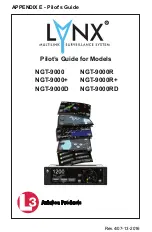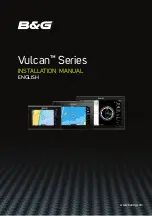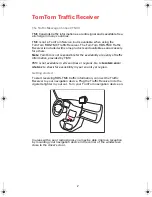
CAP 413
Radiotelephony Manual
Chapter 8 Page 2
Wales and SW England. In circumstances where 121.5 MHz DF data is lacking, the
controller’s ability to assist a pilot who is uncertain of his position is very limited, and
will depend on such factors as the availability of SSR information and the amount and
accuracy of the information provided by the pilot about his route, last known position
and observed landmarks.
1.3.3
Certain UK aerodromes can also offer civil pilots an effective emergency
communications and aid service. Some maintain a continuous watch on 121.5 MHz,
but not all are equipped with VDF or SSR. Others do not normally listen out on
121.5 MHz but they do have VDF and may be asked by the Emergency Controller to
provide DF bearing information on an aircraft, and other assistance. Where a bearing
is required for fixing purposes from an airfield which has VDF but not on 121.5 MHz,
the Emergency Controller may instruct the pilot to change temporarily to the
frequency on which VDF is available.
1.4
UHF and VHF Emergency Service – General Procedures
1.4.1
Pilots should address their emergency calls on 121.5 MHz or 243.0 MHz to ‘London
Centre’ when south of N55°, and ‘Scottish Centre’ when north of N55°. If doubt exists
about the appropriate centre, it is not necessary to address a specific station. Once
two-way communication has been established, pilots should not leave 121.5 MHz or
243.0 MHz without telling the controller. The use of special D&D Sections at the
ACCs in the provision of emergency services is unique to the UK. Detailed information
on related UK Search and Rescue (SAR) procedures is contained in the GEN Section
of the UK AIP.
1.4.2
Pilots are urged – in their own interests – to request assistance from the emergency
service as soon as there is any doubt about the safe conduct of their flight. Even then,
the provision of assistance may be delayed if a pilot does not pass clear details of his
difficulties and requirements, using the international standard RTF prefix ‘MAYDAY,
MAYDAY, MAYDAY’ or ‘PAN PAN, PAN PAN, PAN PAN’ as appropriate. For example,
a vague request from a pilot for ‘confirmation of position’ is unlikely to be accorded
as much priority as would be given to a statement that he is lost. If, subsequent to
the transmission of a ‘MAYDAY’ or ‘PAN’, a pilot considers the problem not to be as
serious as first thought and priority attention is no longer required, the emergency
condition may be cancelled at the pilot’s discretion. It is invariably preferable for pilots
believing themselves to be facing emergency situations to declare them as early as
possible and then cancel later if they decide the situation allows.
1.4.3
If a pilot is already in communication with a civil or military ATSU, before the
emergency arises, assistance should be requested from the controller on the
frequency in use. In this case, any SSR code setting previously assigned by ATC
(other than the Conspicuity Code 7000) should be retained until instructions are
received to change the code setting.
1.4.4
If, however, the pilot is not in direct communication with an ATSU and the aircraft is
equipped with an SSR transponder it should be switched, preferably before the
emergency call is made, to Emergency Code 7700, with Mode C if available. If the
transponding aircraft is high enough to be within secondary radar cover, the selection
of the Emergency 7700 Code will alert the Emergency Controller to the presence of
an incident by means of an audio and visual warning. The received SSR plot will show
the precise location of the aircraft on the controller’s radar display, and will then
obviate the need for the emergency controller to carry out the more time-consuming
manual aircraft position plotting procedure. Information on SSR operating procedures,
including Special Purpose Codes 7700 (Emergency), 7600 (Radio Failure) and 7500
(Hijack or Other Act of Violence) are detailed in the ENR Section of the UK AIP.
31 March 2011
Summary of Contents for 413
Page 1: ...CAP 413 Radiotelephony Manual Edition 20 www caa co uk Safety Regulation Group ...
Page 2: ......
Page 3: ...CAP 413 Radiotelephony Manual Edition 20 Safety Regulation Group 17 November 2011 ...
Page 6: ...CAP 413 Radiotelephony Manual Amendment Number Amendment Date Incorporated by Incorporated on ...
Page 10: ...INTENTIONALLY LEFT BLANK ...
Page 18: ...INTENTIONALLY LEFT BLANK ...
Page 20: ...INTENTIONALLY LEFT BLANK ...
Page 68: ...INTENTIONALLY LEFT BLANK ...
Page 126: ...INTENTIONALLY LEFT BLANK ...
Page 162: ...INTENTIONALLY LEFT BLANK ...
Page 170: ...INTENTIONALLY LEFT BLANK ...
Page 178: ...INTENTIONALLY LEFT BLANK ...
Page 206: ...INTENTIONALLY LEFT BLANK ...
Page 248: ...INTENTIONALLY LEFT BLANK ...
Page 254: ...INTENTIONALLY LEFT BLANK ...
Page 264: ...INTENTIONALLY LEFT BLANK ...
















































